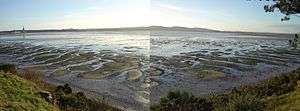Montrose Basin
| Designations | |
|---|---|
| Official name | Montrose Basin |
| Designated | 3 February 1995 |
| Reference no. | 716[1] |

The Montrose Basin is part of the estuary of the South Esk forming a tidal basin near to the town of Montrose, Angus, on the east coast of Scotland.
The nature reserve in this embayment is internationally important for pink-footed geese, red knot and common redshank and is nationally important for common shelduck, wigeon and common eider ducks. It is also popular with mute swans, oystercatchers and northern lapwings as well as smaller birds. Breeding birds are preyed on by peregrine falcons and sparrowhawks. The visitor centre, run by the Scottish Wildlife Trust, is accessible from the A92 road.
The swans give the Basin its old, more poetic name, the "Sea of Swans".
The Montrose Basin Heritage Society was formed in 1999 to bring together information about the basin, including its history and archaeology.
The Basin has been exploited for its seafood. At one time Montrose was Scotland's second largest exporter of salmon; and mussel cultivation gave it the largest mussel beds in the country during the 19th and early 20th centuries. Eels have also been an important catch.
The Montrose Basin was hit by a tsunami in 6100 BC, generated by the massive underwater Storegga Slide, in Norway. It was 70 feet (21 m) high when it hit the basin, with the waters travelling inland as far as Forfar.
See also
References
- ↑ "Montrose Basin". Ramsar Sites Information Service. Retrieved 25 April 2018.
External links
- Reserve's website
- Montrose Basin Live Webcam
- Visitor Centre information
- DEFRA report
- Map sources for Montrose Basin
Coordinates: 56°42′29″N 2°30′11″W / 56.70818°N 2.50305°W